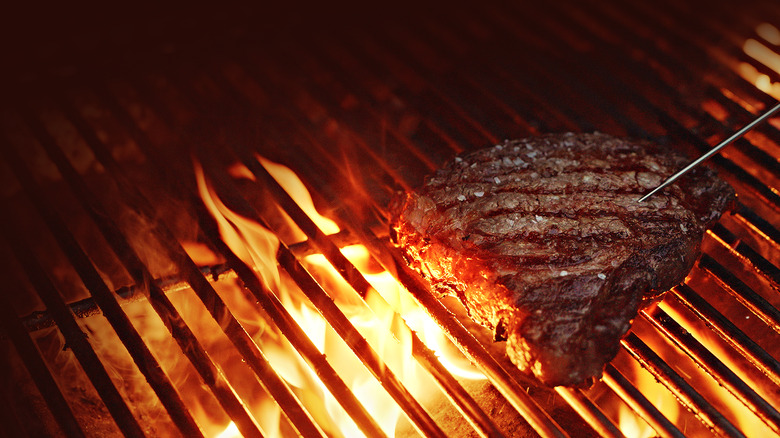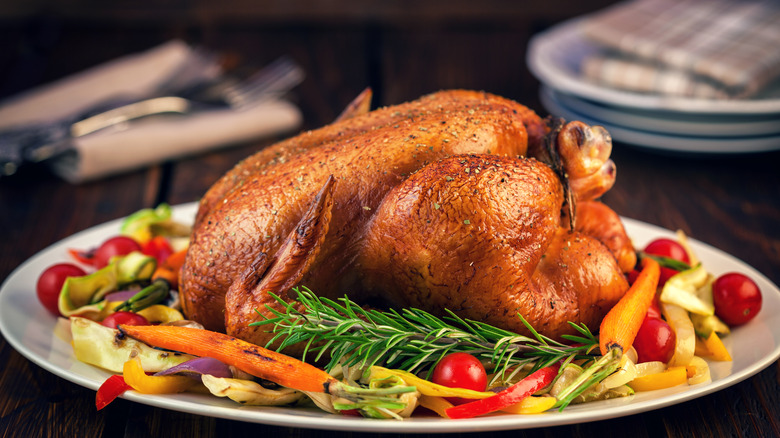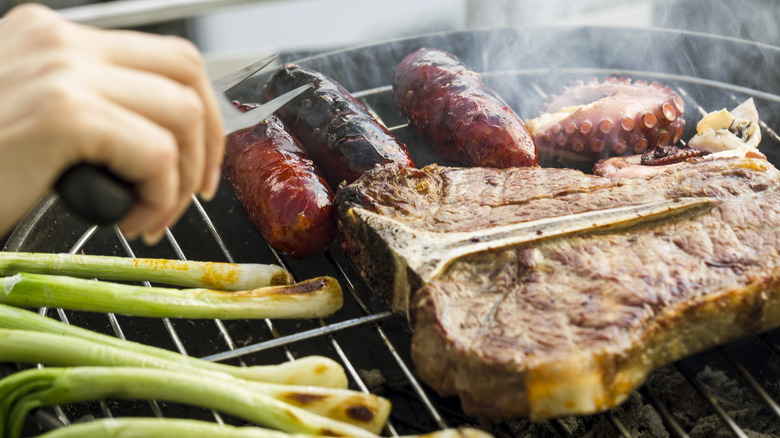Why Meat Changes Color As It's Cooked
On the surface, steak appears to be one of the simplest dishes to cook. You really only need two ingredients — steak and salt (or other seasonings) — and most cooking methods, such as grilling and pan-searing, take minimal time and equipment. Yet, even still, steak seems to attract more attention than any other dish regarding the best cooking methods.
There have been innumerable recipes, articles, and videos dedicated to teaching the art of cooking steak. For the most part, all focus on the same aspect of the process, namely steak doneness and temperature, and keeping the insides pink. However, there is one part of the steak that you absolutely want to be brown, if not blackened — and that's the exterior. This matter extends well beyond steak to virtually every type of meat there is.
Browning is crucial to the flavor of meat. The perfect smashburger has a dark, crisp crust; the best roast chicken has crackly brown skin; and blackened shrimp should be, well, blackened of course. Without the color, you lose an entire dimension of flavor. That's because, as the color changes, new chemicals form in the meat that create entirely new aromas, which elevate the flavor. These dramatic changes can be triggered by a chemical process called the Maillard reaction (also known simply as browning), which is one of the most important forces in culinary chemistry.
How the Maillard reaction works
The Maillard reaction is basically a more complex version of caramelization. Caramelization occurs when carbohydrates, specifically sugars, are heated beyond 330 degrees Fahrenheit, changing their color and flavor. The Maillard reaction takes that one step further by adding amino acids to the mix. Amino acids, the building blocks of protein, react with sugars and heat to create hundreds of new compounds.
While it may be odd to think of meat as containing sugar, it actually does. All foods contain some amount of natural sugar, it's just that many of them contain such small quantities that FDA regulations don't require them to be listed on nutrition labels. So, even though meats have zero grams of sugar listed on nutrition labels, the tiny amount of sugar they do have can trigger the Maillard reaction.
The compounds produced by the Maillard reaction create new layers of flavor, but there's one particular compound that does a different job. In the very final step, after all those flavorful compounds have been unlocked, new molecules called melanoidins form. You can probably guess what they do based on the fact that they share the same prefix as melanin and melanoma; that's right, melanoidins are the reason that meat gets darker when you cook it.
How to create the Maillard reaction in cooking
Mastering the Maillard reaction won't just put attractive grill marks on your steak, it's the secret to getting maximum flavor from any meat you want to cook. But the process doesn't just happen automatically; you need to create the perfect conditions when you cook to realize it. The three keys to the Maillard reaction are heat, time, and moisture, and each one has to land within a certain range to produce the desired effects in meat.
It takes pretty high heat to trigger the Maillard reaction, but not as high as in caramelization. The Maillard reaction begins between 250 and 300 degrees Fahrenheit, which is why you need high temperatures as on a grill to get a really good sear on meat. So, since water boils at 212 degrees, the Maillard reaction cannot occur in boiled or braised meats. Those kinds of cooked meats change color as well, but for different reasons. Heat causes myoglobin, the chemical that gives raw meat its color, to break down into new, darker, compounds. This doesn't have the same effect on flavor as the Maillard reaction does.
It's also important to know that the Maillard reaction occurs quickly. Cook for too long, or let the temperature get too high (generally above 355 degrees), and you'll flat-out burn the food. And don't forget the absence of moisture. Meat needs to be totally dry on the surface for the Maillard reaction to occur. If there's any moisture, it won't get hot enough. So, to get the best browning, pat the meat dry, and avoid over-salting.


